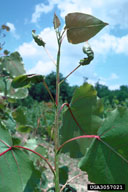Poplar leafcurl midge
Prodiplosis morrisi Gagné (Diptera: Cecidomyiidae)
Orientation to pest
The poplar leafcurl midge, Prodiplosis morrisi Gagné, is a native North American cecidomyiid fly that lays its eggs on developing cottonwood terminals. The larvae feed on surfaces of expanding leaves, causing them to curl into elongated, largely cylindrical shapes. Leaves may stay green with only curled edges turning brown, or leaf may be killed. With sufficient feeding, terminal shoots may become stunted or killed. Trees of all sizes may be attacked. There may be up to five or more generations per year. Each generation damages 1 to 2 whorls of leaves, and because there is a short period between generations, normal leaves alternate with damaged leaves. The many larvae that develop in each curled leaf drop to the soil beneath the tree to pupate. Larvae of the last generation overwinter in the soil.
Hosts commonly attacked
This midge attacks various species of Populus, including eastern cottonwood (Populus deltoides W. Bartram ex Humphry Marshall), quaking aspen (Populus tremuloides Michx.), and Populus hybrids are attacked.
Distribution
This species is of greatest importance in the southern United States, in cottonwood plantations.
Images of poplar leafcurl midge
| Figure 1. Injury to cottonwood seedling from poplar leafcurl midge, Prodiplosis morrisi |
Important biological control agents related to this pest species
No information is available on natural enemies of this species.
Web links for information on poplar leafcurl midge
Articles
- Gagné, R. J. 1966. A new species of Prodiplosis (Diptera: Cecidomyiidae) found in leaf curls on Populus deltoides. Annals of the Entomological Society of America 59: 1154-1157.
- Gagné, R. J. 1989. The Plant-feeding Gall Midges of North America. Cornell University Press. Ithaca, New York, 340 pp.
- Ostry, M. E., L. F. Wilson, H. S. McNabb, Jr., and L. M. Moore. 1988. A Guide to Insect, Disease, and Animal Pests of Poplars. Agricultural Handbook No. 677. U.S. Department of Agriculture, Washington, D.C., 118 pp.
- Skuhravý, V., M. Skuhravá and J. W. Brewer. 1997. Gall midges (Dipt., Cecidomyiidae) associated with Populus tremula, P. tremuloides and their hybrid (Salicaceae). Journal of Applied Entomology 121: 315-320.




